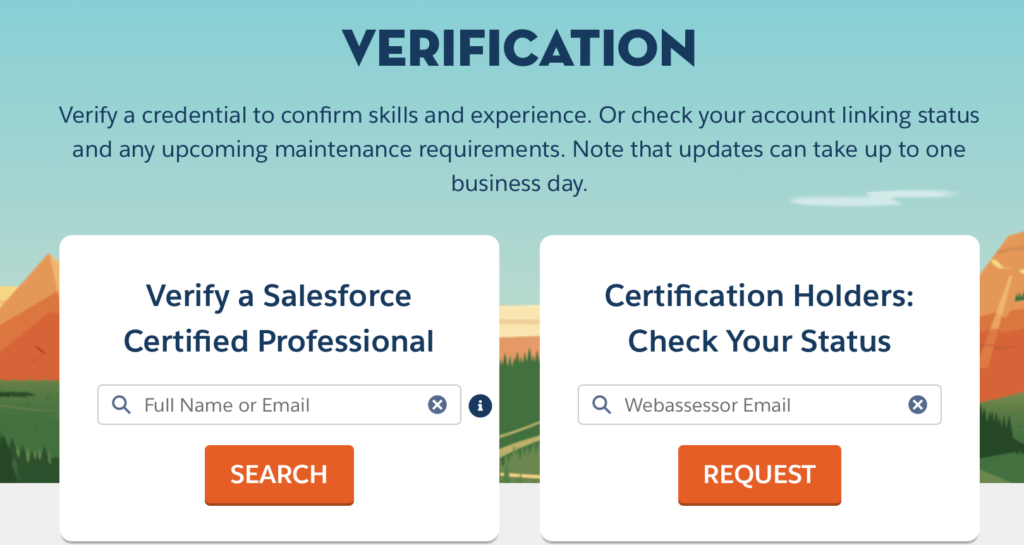Salesforce certifications are vital for professionals looking to demonstrate expertise in Salesforce technologies. Once certified, it’s essential to verify these credentials, whether for job applications, client assurance, or personal record-keeping. This guide explains Salesforce certification verification options.
1. Importance of Salesforce Certification Verification
- Prove Expertise: Validates your skills in Salesforce, enhancing professional credibility.
- Employer Verification: Employers can confirm your certifications during hiring, building trust in your abilities.
- Credential Management: Helps track verified certifications, especially for individuals with multiple credentials.
Salesforce provides several methods to verify certifications, ensuring your credentials are legitimate for resumes, LinkedIn, or other platforms.

2. Salesforce Certification Verification Techniques
A. Verification by Credential ID
Each Salesforce certification has a unique Credential ID. Here’s how to use it for verification:
- Locate Credential ID: Find it in your certification email or on the Trailhead account.
- Go to Salesforce Credential Verification Page: Access the Salesforce Credential Verification page.
- Enter Credential ID: Input the Credential ID in the search field.
- View Results: If valid, Salesforce will display certification details for verification.
B. Verification by Name
Another way to verify Salesforce certifications is by searching with your name:
- Visit the Salesforce Credential Verification page.
- Enter your name as it appears on certification records.
- Select the relevant certification from the list displayed under your name.
C. Certification Verification Opt-In
Salesforce’s opt-in feature allows public display of certifications:
- Log in to Trailhead: Access your account where certifications are stored.
- Enable Verification Opt-In: In profile settings, go to the certification section and enable “Verification Opt-In.”
- Share Certification URL: A unique URL is generated, which can be shared on LinkedIn, resumes, or other platforms for easy verification.
3. Salesforce Certification Number and ID
Each certification has a unique number and ID, which are used in verification processes:
- Certification Number: Often included on certification PDFs and proves the certification’s authenticity.
- Credential ID: Used for verification on Salesforce’s Credential Verification page.
4. Salesforce Certification Requirements
| Certification Level | Example Certifications | Requirements |
|---|---|---|
| Entry-Level | Salesforce Administrator | Basic knowledge of Salesforce platform |
| Intermediate | Salesforce Advanced Administrator | Salesforce Administrator certification |
| Advanced | Salesforce Architect | Project-based experience and multiple prerequisites |
| Specialized | Salesforce CPQ Specialist | Experience in CPQ and related fields |
Salesforce certifications vary in complexity, with each level focusing on specific skill sets for professionals aiming to specialize in Salesforce technology.
5. Managing and Validating Salesforce Certifications
Tips for Salesforce Professionals
- Update Records: Ensure certifications are up-to-date in your Trailhead profile for easy verification.
- Enable Public Opt-In: Display certifications publicly if open to job offers or consulting opportunities.
- Add to LinkedIn: Display verified certifications on LinkedIn to enhance professional visibility.
Tips for Employers
- Request Credential ID: Ask for the candidate’s credential ID and verify it on the Salesforce verification page.
- Use Certification URL: If provided, check the public URL shared by the candidate for verification.
Conclusion
Salesforce certification verification is a straightforward yet essential process that authenticates skills and expertise. Using credential IDs, name searches, and opt-in verification, Salesforce ensures that each certification is easily validated. With this guide, professionals can confidently showcase their Salesforce credentials, and employers can efficiently validate them for hiring and project purposes.
For more assistance, visit the Salesforce Credential Verification page.